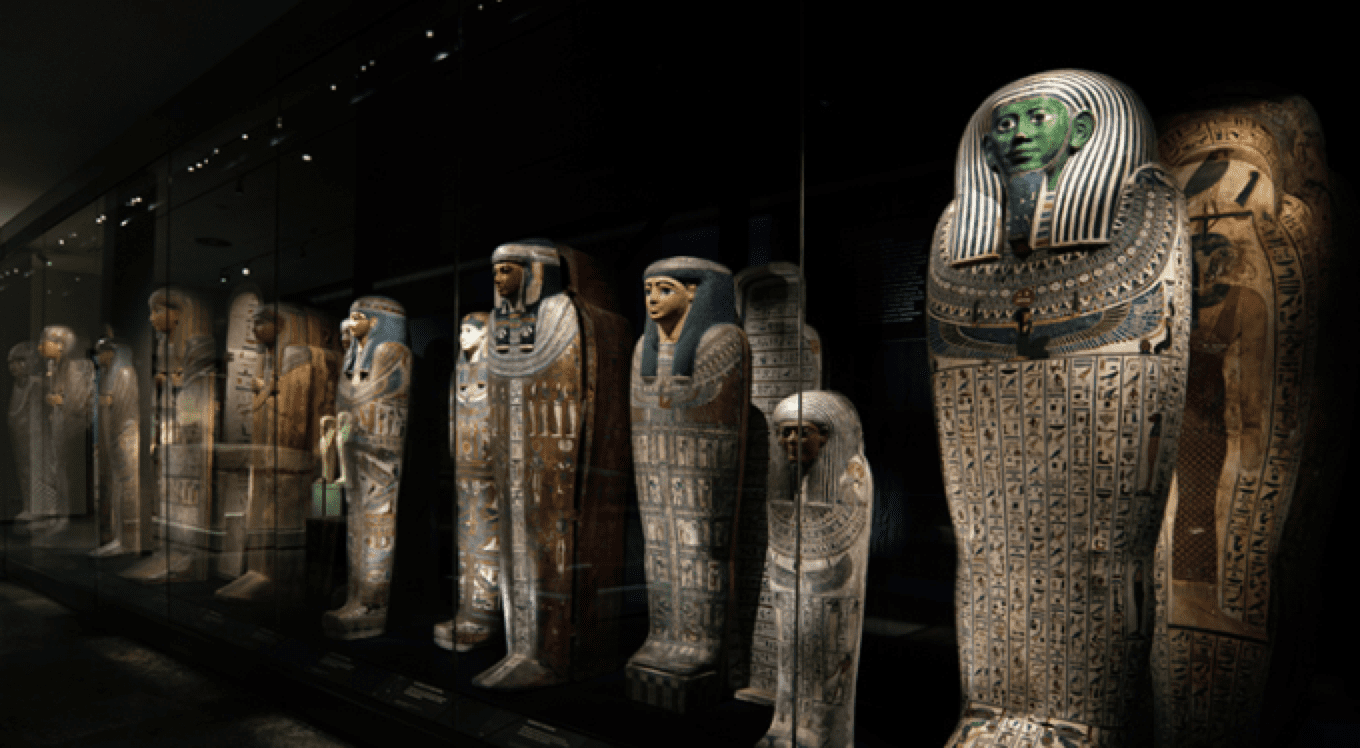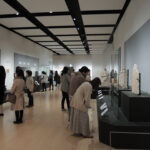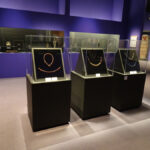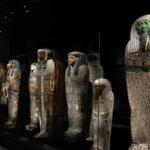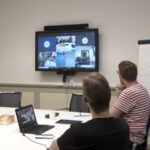March 2020: 38 crates, in neat rows in the secure and air-conditioned storage facility of a Dutch art transporter are ready to be picked up for transport. Safely packed in the crates are approximately 250 objects from the Egyptian collection of the National Museum of Antiquities in Leiden, the Netherlands (Rijksmuseum van Oudheden or ‘RMO’ for short), ready for a touring exhibition in Japan. The objects vary from modern scale models and 18th century prints to 2,500-year-old mummies, reliefs and statuary, all part of the exhibition Egypt. Land of Discoveries.
The exhibition is a collaboration between the Japanese media company The Tokyo Shimbun and the National Museum of Antiquities. The museum and this media company have a long history of collaboration, the first project they undertook together being a travelling exhibition showcasing the best of RMO’s Egyptian collection, which was presented in 1987 at seven major cultural institutions around the country. The storyline of Egypt. Land of Discoveries was developed by Lara Weiss and Daniel Soliman, curators of the Egyptian collection at RMO, and adapted for a Japanese audience in collaboration with professor of Egyptology from Chubu University, Tomoaki Nakano. Our team at RMO also provided photography and developed some digital content (mummy scans, game, clips), which could be used by the Japanese museums. The Tokyo Shimbun collaborated with the different venues in Japan on the design and content, making sure that each venue could show an exhibition catered to their unique audiences and galleries.
After a busy year of development, the exhibition was ready for international travel for a premiere opening on 25 April 2020 at the Kyushu National Museum in Fukuoka. And then Covid hit the world. On 15 March 2020, the Netherlands went into its first – very strict – lockdown. Possibilities to get the objects to Japan were sought but not found, and soon Japan also went into lockdown, with museums closing throughout the country. The first two venues of the tour had to be cancelled as the world grinded to a halt in the spring of 2020.
We adapted the mounting [and created] an object book with detailed instructions and supporting text translated into Japanese.
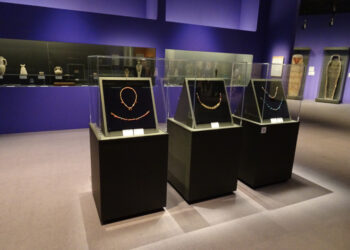
In August 2020, the teams on both sides of the world had a glimmer of hope: museums in Japan were allowed to reopen and international transport was possible again. The only problem, faced by many museums, was the difficulty of sending couriers abroad in person due to strict regulations. Within RMO, possibilities for how to tackle an installation without couriers were thoroughly discussed. It was soon decided with the partners in Japan that the exhibition would be installed remotely via a digital connection.
The decision was a tough one to make, but certain factors helped to make it easier. Firstly, RMO and the Tokyo Shimbun had been longstanding partners, so there was – and still is – a lot of trust between both parties. Secondly, as we at RMO had sent one large travelling exhibition and some fairly substantial loans to Japan over the past ten years, we knew that certain employees of the specialised art installation company that had been appointed for the Land of Discoveries exhibition had worked with our collection before, under the supervision of our couriers. We therefore asked if the team could be arranged so that those particular employees would be assigned to the task of installing our exhibition.
In Japan, turnover times are often very short between the venues of a touring exhibition. To make sure that we would be able to stay on track with such a tight schedule, we adapted the mounting so that a lot of objects were pre-mounted or had made to measure mounts, which could be easily installed. This turned out to be a great advantage for a remote installation. An object book was made with detailed mounting instructions and – where necessary – photos or drawings of mounts. The object book was translated into Japanese and sent to the team in Japan.
The crates were shipped to Japan on 18 August, followed by a separate shipment of a tool trolley filled with everything one could possibly need during the installation: silicon tubing, silicone drops, drill sets, loggers, and conservation material. The sturgeon glue we had packed into the tool cart had to be taken out in a bit of a hurry, as none of us had realised that sturgeon is on the CITES list of protected animals. One never stops learning!
The Dutch team at RMO was slightly hesitant about the installation of three very heavy stelae, as these specific objects are notoriously difficult to install, even for us. After consultation with the Japanese team, it was decided to leave these big objects in their crates, only to be installed in the presence of RMO couriers, who could advise on their installation. It turned out that what started off as a problem, actually turned out to be a solution. To prevent the spread of Covid-19, Japan had strict social distancing measures in place. Taking out three big objects gave the much needed room to space out visitors. As the Dutch footballer and football coach Johan Cruyff famously said: ‘every downside has its upside’!
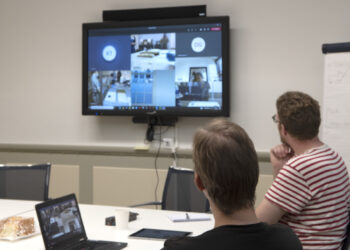
Four cameras had been set up to allow the Dutch team to watch the installation process in the exhibition gallery.
The crates were picked up by our colleagues in Japan and safely transported to the Aichi Prefectural Museum of Art in Nagoya. Four cameras had been set up to allow the Dutch team to watch the installation process in the exhibition gallery: one camera pointing at the table for the condition checks, one pointing at the showcase in which the object would be placed and displayed, one showing the crate that was being unpacked and, last but not least, one moving camera held by a member of the Japanese team. Using Microsoft Teams on a big screen in our meeting room meant that the Dutch team could watch the unpacking and installation while being able to easily discuss any questions or problems raised by the Japanese team.
To help with the language barrier, the Japanese team had appointed a Japanese-English interpreter. The RMO team also hired a Dutch-Japanese interpreter, who assisted our team in Leiden for all the days of digital installation and again for the digital take down. To prepare the interpreter for the task, we had shared some materials with him that are often used during installation as well as some information about our collection. For most interpreters, a word like ‘ushabti’ – a funerary figurine – is not used in regular day to day conversation.
At 6 am every morning (2 pm Japan time) one conservator, one collection manager, the interpreter and the project manager opened the link to a Microsoft Teams meeting to oversee condition checking – with the help of an independent Japanese conservator – and installation. Some of our Dutch colleagues dialled in from home, giving our Japanese colleagues glimpses of family life in the Netherlands. Due to Covid measures, only a few of us were at the museum itself, in the general meeting room, with a coffee machine and a stack of cookies and cake nearby to keep our energy levels up.
One of the best things about touring exhibitions is working with an international team, and seeing the teams come together during the days of installation and take down. Digitally, the feeling is of course different. Still, we did manage to share quite a lot of moments of fun during the installation. For example, the slight miscommunication when we were talking in Dutch during the installation of a heavy statue: we were saying, ‘Oh wow, they use sliding paper instead of sliding slats, that’s so cool! We should buy some when we’re in Japan!’ Our Japanese colleagues thought they were doing something wrong (this was one of the first days during installation), so they anxiously stopped and asked through their interpreter if all was OK, and had a good laugh when our interpreter explained what we had been talking about. Needless to say, a shopping trip to several Japanese hardware stores will be organised once couriers can travel to Japan again without the 14-day quarantine.
One of the best things about touring exhibitions is [...] seeing the teams come together [...]. Digitally, the feeling is of course different. Still, we did manage to share quite a lot of moments of fun.
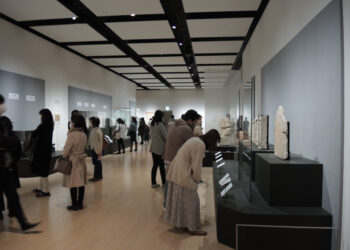
Although the digital installations and take downs were not ideal, they did bring about some positives. All collection managers and conservators at the museum participated in turn in the remote sessions, thereby getting to know the Japanese colleagues, the work routine, and the ins and outs of the process. The digital meetings also gave the interns of the conservation department the unique opportunity to join us for some sessions. Some other colleagues, from the financial department, for example, asked if they could watch the work for a few minutes, as they normally do not have the opportunity to see an installation from up close, and this gave them some insight into the work that goes into a travelling exhibition.
After three digital installations and two take downs during the global pandemic, we have come to the conclusion that it is indeed possible to digitally install and take down a travelling exhibition with this many objects, in an emergency situation. For as long as necessary, installation and take down will be done remotely by RMO’s team of collection managers and conservators, with the help of our interpreter. In the future, we will make sure to always send out exhibitions and loans as ‘pandemic proof’ as possible, pre-mounting objects whenever possible, sending supports for all objects and with an object installation book included.
However, as soon as we can send couriers to Japan without them needing to quarantine for two weeks, we will do so. First of all, we would like to check the condition of the objects for ourselves after three venues. Although much can be learnt from high quality images, it is not the same as checking the objects in real life, using all your senses. Secondly, we would also like to be there for the packing, to see if all the crates are still in order and if any packaging needs tweaking. Thirdly we would very much like to help with the installation of the three heavy stelae, so that visitors to the exhibition can finally see those masterpieces as well. Last but not least, we are all very much looking forward to seeing our Japanese colleagues in real life, to thank them for the amazing care they have taken of our objects, and to celebrate our successful collaboration.
About the exhibition
The exhibition Egypt. Land of Discoveries tells the story of ancient Egypt through discoveries made through the ages: the expeditions of the late 18th and early 19th century, early photography in the 19th century, the Leiden excavations in the 20th century and modern day techniques such as, for example, MRI. The exhibition has been shown in three cities in Japan (Nagoya, Shizuoka and Tokyo) and will travel to a further five. The first two venues had to be cancelled due to the pandemic, but the exhibition will travel to these cities after the last original venue, extending the end date of the Japan tour to the end of summer 2022.
For more information on the tour, visit the Japanese website leidenegypt.jp.

